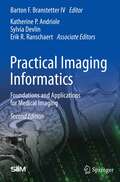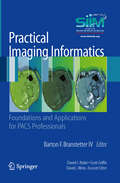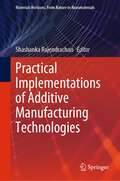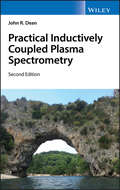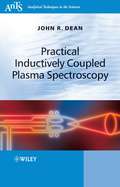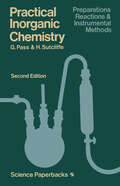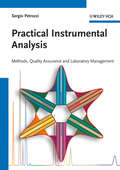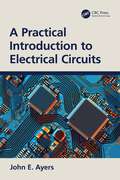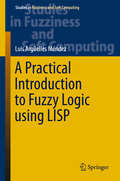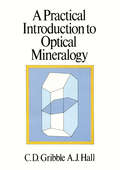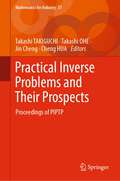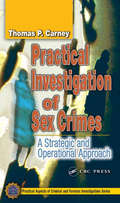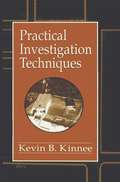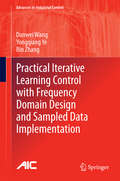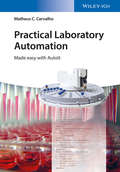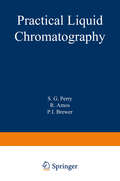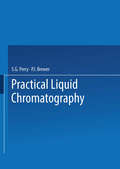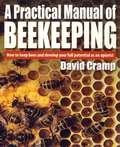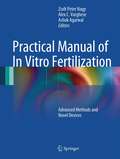- Table View
- List View
Practical Imaging Informatics: Foundations and Applications for Medical Imaging
by Barton F. Branstetter IVThis new edition is a comprehensive source of imaging informatics fundamentals and how those fundamentals are applied in everyday practice. Imaging Informatics Professionals (IIPs) play a critical role in healthcare, and the scope of the profession has grown far beyond the boundaries of the PACS. A successful IIP must understand the PACS itself and all the software systems networked together in the medical environment. Additionally, an IIP must know the workflows of all the imaging team members, have a base in several medical specialties and be fully capable in the realm of information technology.Practical Imaging Informatics has been reorganized to follow a logical progression from basic background information on IT and clinical image management, through daily operations and troubleshooting, to long-term planning. The book has been fully updated to include the latest technologies and procedures, including artificial intelligence and machine learning. Written by a team of renowned international authors from the Society for Imaging Informatics in Medicine and the European Society of Medical Imaging Informatics, this book is an indispensable reference for the practicing IIP. In addition, it is an ideal guide for those studying for a certification exam, biomedical informaticians, trainees with an interest in informatics, and any professional who needs quick access to the nuts and bolts of imaging informatics.
Practical Imaging Informatics: Foundations and Applications for PACS Professionals
by Barton F. BranstetterAttention SIIM Members: a special discount is available to you; please log in to the SIIM website at www.siim.org/pii or call the SIIM office at 703-723-0432 for information on how you can receive the SIIM member price. Imaging Informatics Professionals (IIPs) have come to play an indispensable role in modern medicine, and the scope of this profession has grown far beyond the boundaries of the PACS. A successful IIP must not only understand the PACS itself, but also have knowledge of clinical workflow, a base in several medical specialties, and a solid IT capability regarding software interactions and networking. With the introduction of a certification test for the IIP position, a single source was needed to explain the fundamentals of imaging informatics and to demonstrate how those fundamentals are applied in everyday practice. Practical Imaging Informatics describes the foundations of information technology and clinical image management, details typical daily operations, and discusses rarer complications and issues.
Practical Implementations of Additive Manufacturing Technologies (Materials Horizons: From Nature to Nanomaterials)
by Shashanka RajendrachariThis book gives in-depth information about evolution of additive manufacturing from a few decades to the present explaining how the technology has been improved with time and its practical implementation of the technology in various applications and industries. It describes the different types of additive manufacturing methods used to prepare materials and their advantages, followed by the limitations. This includes the fabrication of metal, polymer, biomaterial, hybrid nanomaterial, smart material, and ceramic materials using additive manufacturing methods used in many applications such as 3D printed batteries, supercapacitors, electrochemical sensors, biosensors, aircraft interior components, rocket engines components, automobile components, and medical implants. It also describes advanced applications of additive manufacturing materials in the construction, biomedical, and sports industries. In addition, the book also deep dives into the environmental impact and economic benefits of additive manufacturing industries. A special chapter is included to give an overview on the general type of job opportunities for engineering graduates and research scholars seeking to find employment in additive manufacturing companies. In short, the content of this book targets primarily researchers, engineering students (bachelors and masters), and industrial engineers.
Practical Inductively Coupled Plasma Spectrometry
by John R. DeanA new edition of this practical approach to sampling, experimentation, and applications in the field of inductively coupled plasma spectrometry The second edition of Practical Inductively Coupled Plasma Spectrometry discusses many of the significant developments in the field which have expanded inductively coupled plasma (ICP) spectrometry from a useful optical emission spectroscopic technique for trace element analysis into a source for both atomic emission spectrometry and mass spectrometry, capable of detecting elements at sub-ppb (ng mL−1) levels with good accuracy and precision. Comprising nine chapters, this new edition has been fully revised and up-dated in each chapter. It contains information on everything you need to practically know about the different types of instrumentation as well as pre- and post-experimental aspects. Designed to be easily accessible, with a ‘start-to-finish’ approach, each chapter outlines the key practical aspects of a specific aspect of the topic. The author, a noted expert in the field, details specific applications of the techniques presented, including uses in environmental, food and industrial analysis. This edition: Emphasizes the importance of health and safety; Provides advanced information on sample preparation techniques; Presents an updated chapter on inductively coupled plasma mass spectrometry; Features a new chapter on current and future development in ICP technology and one on practical trouble shooting and routine maintenance. Practical Inductively Coupled Plasma Spectrometry offers a practical guide that can be used for undergraduate and graduate students in the broad discipline of analytical chemistry, which includes biomedical science, environmental science, food science and forensic science, in both distance and open learning situations. It also provides an excellent reference for those in postgraduate training in these fields.
Practical Inductively Coupled Plasma Spectrometry
by John R. DeanA new edition of this practical approach to sampling, experimentation, and applications in the field of inductively coupled plasma spectrometry The second edition of Practical Inductively Coupled Plasma Spectrometry discusses many of the significant developments in the field which have expanded inductively coupled plasma (ICP) spectrometry from a useful optical emission spectroscopic technique for trace element analysis into a source for both atomic emission spectrometry and mass spectrometry, capable of detecting elements at sub-ppb (ng mL−1) levels with good accuracy and precision. Comprising nine chapters, this new edition has been fully revised and up-dated in each chapter. It contains information on everything you need to practically know about the different types of instrumentation as well as pre- and post-experimental aspects. Designed to be easily accessible, with a ‘start-to-finish’ approach, each chapter outlines the key practical aspects of a specific aspect of the topic. The author, a noted expert in the field, details specific applications of the techniques presented, including uses in environmental, food and industrial analysis. This edition: Emphasizes the importance of health and safety; Provides advanced information on sample preparation techniques; Presents an updated chapter on inductively coupled plasma mass spectrometry; Features a new chapter on current and future development in ICP technology and one on practical trouble shooting and routine maintenance. Practical Inductively Coupled Plasma Spectrometry offers a practical guide that can be used for undergraduate and graduate students in the broad discipline of analytical chemistry, which includes biomedical science, environmental science, food science and forensic science, in both distance and open learning situations. It also provides an excellent reference for those in postgraduate training in these fields.
Practical Inductively Coupled Plasma Spectroscopy (Analytical Techniques in the Sciences (AnTs) *)
by John R. DeanThe book provides an up-to-date account of inductively coupled plasmas and their use in atomic emission spectroscopy and mass spectrometry. Specific applications of the use of these techniques are highlighted including applications in environmental, food and industrial analysis. It is written in a distance learning / open learning style; suitable for self study applications. It contains contain self-assessment and discussion questions, worked examples and case studies that allow the reader to test their understanding of the presented material.
Practical Inorganic Chemistry: Preparations, reactions and instrumental methods
by G. PassIn revising the text opportunity has been taken to introduce SI units throughout. An Appendix has been included which contains tables of SI units and a table of conversion factors for use when consulting data in non-SI units. Chapter 19 now includes experiments demon strating the use of ion-exchange and solid-liquid chromatography_ Exercises involving colorimetry have been included in Chapter 17. These techniques are introduced as part of a complementary exercise where their relevance is seen as part of a complete piece of work. Minor improvements have been made to some of the experimental procedures and we are grateful to those who have made helpful suggestions in this respect. G. PASS H. SUTCLIFFE iii Preface to the First Edition The student of inorganic chemistry is fortunate in having a wide choice of textbooks covering the descriptive and theoretical aspects of the sUbject. There is no comparable choice of textbooks covering practical inorganic chemistry. Moreover, there is a tendency for many students to draw an unfortunate distinction between chemistry taught in the lecture room, and laboratory work. Consideration of these points prompted the preparation of this book, in which we have attempted to emphasize the relationship between theory and practice.
Practical Instrumental Analysis: Methods, Quality Assurance, and Laboratory Management
by Sergio PetrozziThis practical book in instrumental analytics conveys an overview of important methods of analysis and enables the reader to realistically learn the (principally technology-independent) working techniques the analytical chemist uses to develop methods and conduct validation. What is to be conveyed to the student is the fact that analysts in their capacity as problem-solvers perform services for certain groups of customers, i.e., the solution to the problem should in any case be processed in such a way as to be "fit for purpose". The book presents sixteen experiments in analytical chemistry laboratory courses. They consist of the classical curriculum used at universities and universities of applied sciences with chromatographic procedures, atom spectrometric methods, sensors and special methods (e.g. field flow fractionation, flow injection analysis and N-determination according to Kjeldahl). The carefully chosen combination of theoretical description of the methods of analysis and the detailed instructions given are what characterizes this book. The instructions to the experiments are so detailed that the measurements can, for the most part, be taken without the help of additional literature. The book is complemented with tips for effective literature and database research on the topics of organization and the practical workflow of experiments in analytical laboratory, on the topic of the use of laboratory logs as well as on writing technical reports and grading them (Evaluation Guidelines for Laboratory Experiments). A small introduction to Quality Management, a brief glance at the history of analytical chemistry as well as a detailed appendix on the topic of safety in analytical laboratories and a short introduction to the new system of grading and marking chemicals using the "Globally Harmonized System of Classification and Labelling of Chemicals (GHS)", round off this book. This book is therefore an indispensable workbook for students, internship assistants and lecturers (in the area of chemistry, biotechnology, food technology and environmental technology) in the basic training program of analytics at universities and universities of applied sciences.
Practical Instrumental Analysis: Methods, Quality Assurance, and Laboratory Management
by Sergio PetrozziThis practical book in instrumental analytics conveys an overview of important methods of analysis and enables the reader to realistically learn the (principally technology-independent) working techniques the analytical chemist uses to develop methods and conduct validation. What is to be conveyed to the student is the fact that analysts in their capacity as problem-solvers perform services for certain groups of customers, i.e., the solution to the problem should in any case be processed in such a way as to be "fit for purpose". The book presents sixteen experiments in analytical chemistry laboratory courses. They consist of the classical curriculum used at universities and universities of applied sciences with chromatographic procedures, atom spectrometric methods, sensors and special methods (e.g. field flow fractionation, flow injection analysis and N-determination according to Kjeldahl). The carefully chosen combination of theoretical description of the methods of analysis and the detailed instructions given are what characterizes this book. The instructions to the experiments are so detailed that the measurements can, for the most part, be taken without the help of additional literature. The book is complemented with tips for effective literature and database research on the topics of organization and the practical workflow of experiments in analytical laboratory, on the topic of the use of laboratory logs as well as on writing technical reports and grading them (Evaluation Guidelines for Laboratory Experiments). A small introduction to Quality Management, a brief glance at the history of analytical chemistry as well as a detailed appendix on the topic of safety in analytical laboratories and a short introduction to the new system of grading and marking chemicals using the "Globally Harmonized System of Classification and Labelling of Chemicals (GHS)", round off this book. This book is therefore an indispensable workbook for students, internship assistants and lecturers (in the area of chemistry, biotechnology, food technology and environmental technology) in the basic training program of analytics at universities and universities of applied sciences.
A Practical Introduction to Electrical Circuits
by John E. AyersA Practical Introduction to Electrical Circuits represents a fresh approach to the subject which is compact and easy to use, yet offers a comprehensive description of the fundamentals, including Kirchhoff’s laws, nodal and mesh analysis, Thevenin and Norton’s theorems, and maximum power transfer for both DC and AC circuits, as well as transient analysis of first- and second-order circuits. Advanced topics such as mutual inductance and transformers, operational amplifier circuits, sequential switching, and three-phase systems reinforce the fundamentals. Approximately one hundred solved examples are included within the printed copy. Extra features online include over two hundred additional problems with detailed, step-by-step solutions, and 40 self-service quizzes with solutions and feedback.
A Practical Introduction to Electrical Circuits
by John E. AyersA Practical Introduction to Electrical Circuits represents a fresh approach to the subject which is compact and easy to use, yet offers a comprehensive description of the fundamentals, including Kirchhoff’s laws, nodal and mesh analysis, Thevenin and Norton’s theorems, and maximum power transfer for both DC and AC circuits, as well as transient analysis of first- and second-order circuits. Advanced topics such as mutual inductance and transformers, operational amplifier circuits, sequential switching, and three-phase systems reinforce the fundamentals. Approximately one hundred solved examples are included within the printed copy. Extra features online include over two hundred additional problems with detailed, step-by-step solutions, and 40 self-service quizzes with solutions and feedback.
A Practical Introduction to Fuzzy Logic using LISP (Studies in Fuzziness and Soft Computing #327)
by Luis Argüelles MendezThis book makes use of the LISP programming language to provide readers with the necessary background to understand and use fuzzy logic to solve simple to medium-complexity real-world problems. It introduces the basics of LISP required to use a Fuzzy LISP programming toolbox, which was specifically implemented by the author to “teach” the theory behind fuzzy logic and at the same time equip readers to use their newly-acquired knowledge to build fuzzy models of increasing complexity. The book fills an important gap in the literature, providing readers with a practice-oriented reference guide to fuzzy logic that offers more complexity than popular books yet is more accessible than other mathematical treatises on the topic. As such, students in first-year university courses with a basic tertiary mathematical background and no previous experience with programming should be able to easily follow the content. The book is intended for students and professionals in the fields of computer science and engineering, as well as disciplines including astronomy, biology, medicine and earth sciences. Software developers may also benefit from this book, which is intended as both an introductory textbook and self-study reference guide to fuzzy logic and its applications. The complete set of functions that make up the Fuzzy LISP programming toolbox can be downloaded from a companion book’s website.
A Practical Introduction to Optical Mineralogy
by Colin GribbleMicroscopy is a servant of all the sciences, and the microscopic examina tion of minerals is an important technique which should be mastered by all students of geology early in their careers. Advanced modern text books on both optics and mineralogy are available, and our intention is not that this new textbook should replace these but that it should serve as an introductory text or a first stepping-stone to the study of optical mineralogy. The present text has been written with full awareness that it will probably be used as a laboratory handbook, serving as a quick reference to the properties of minerals, but nevertheless care has been taken to present a systematic explanation of the use of the microscope as well as theoretical aspects of optical mineralogy. The book is therefore suitable for the novice either studying as an individual or participating in classwork. Both transmitted-light microscopy and reflected-light microscopy are dealt with, the former involving examination of transparent minerals in thin section and the latter involving examination of opaque minerals in polished section. Reflected-light microscopy is increasing in importance in undergraduate courses on ore mineralisation, but the main reason for combining the two aspects of microscopy is that it is no longer acceptable to neglect opaque minerals in the systematic petrographic study of rocks. Dual purpose microscopes incorporating transmitted- and reflected-light modes are readily available, and these are ideal for the study of polished thin sections.
Practical Inverse Problems and Their Prospects: Proceedings of PIPTP (Mathematics for Industry #37)
by Takashi Takiguchi Takashi Ohe Jin Cheng Cheng HuaThis book comprises select proceedings of the workshop “Practical inverse problems and their prospects” held online by zoom, from Mar 2nd to Mar. 4th, 2022, supported by Institute of Mathematics for Industry, Kyushu University focusing on cutting-edge research carried out in the areas of practical inverse problems based on industry-academia and interdisciplinary collaborations.Various themes on practical inverse problems covered in this book are medical imaging, non-destructive and non-invasive inspections, viscoelastic waves, remote sensing, infrared light tomography, maintenance of infrastructure, and so on, and mathematical theories in inverse problems are also handled in these proceedings.All papers in this book are written by qualified authors in the practical inverse problems area and also the papers are newly announced. Readers can get leading-edge information on practical inverse problems.
Practical Investigation of Sex Crimes: A Strategic and Operational Approach
by Thomas P. CarneyBecause of the sensitive nature of sex crimes, police officials must develop a specialized set of interviewing skills to effectively investigate them. Written by former Commanding Officer of the Manhattan Special Victims Squad Thomas P. Carney, Practical Investigation of Sex Crimes: A Strategic and Operational Approach provides a day-to-day guide f
Practical Investigation Techniques
by Vernon J. Geberth Kevin B. KinneePractical Investigation Techniques is useful for new as well as veteran investigators to establish a practical standard for conducting a wide range of diverse criminal investigations. Written by a veteran investigator, the book teaches the proper investigative techniques for such criminal activities as extortion, blackmail, credit card fraud, check fraud, fencing operations, employee theft, sports gambling, money laundering, and shoplifting rings. Practical Investigation Techniques is presented in an easy-to-read format and provides a wealth of specific investigation techniques, checklists, and case studies.
Practical Investigation Techniques (Practical Aspects Of Criminal And Forensic Investigations Ser. #11)
by Vernon J. Geberth Kevin B. KinneePractical Investigation Techniques is useful for new as well as veteran investigators to establish a practical standard for conducting a wide range of diverse criminal investigations. Written by a veteran investigator, the book teaches the proper investigative techniques for such criminal activities as extortion, blackmail, credit card fraud, check fraud, fencing operations, employee theft, sports gambling, money laundering, and shoplifting rings. Practical Investigation Techniques is presented in an easy-to-read format and provides a wealth of specific investigation techniques, checklists, and case studies.
Practical Iterative Learning Control with Frequency Domain Design and Sampled Data Implementation (Advances in Industrial Control)
by Danwei Wang Yongqiang Ye Bin ZhangThis book is on the iterative learning control (ILC) with focus on the design and implementation. We approach the ILC design based on the frequency domain analysis and address the ILC implementation based on the sampled data methods. This is the first book of ILC from frequency domain and sampled data methodologies. The frequency domain design methods offer ILC users insights to the convergence performance which is of practical benefits. This book presents a comprehensive framework with various methodologies to ensure the learnable bandwidth in the ILC system to be set with a balance between learning performance and learning stability. The sampled data implementation ensures effective execution of ILC in practical dynamic systems. The presented sampled data ILC methods also ensure the balance of performance and stability of learning process. Furthermore, the presented theories and methodologies are tested with an ILC controlled robotic system. The experimental results show that the machines can work in much higher accuracy than a feedback control alone can offer. With the proposed ILC algorithms, it is possible that machines can work to their hardware design limits set by sensors and actuators. The target audience for this book includes scientists, engineers and practitioners involved in any systems with repetitive operations.
Practical Laboratory Automation: Made easy with AutoIt
by Matheus C. CarvalhoBy closing the gap between general programming books and those on laboratory automation, this timely book makes accessible to every laboratory technician or scientist what has traditionally been restricted to highly specialized professionals. Following the idea of "learning by doing", the book provides an introduction to scripting using AutoIt, with many workable examples based on real-world scenarios. A large portion of the book tackles the traditionally hard problem of instrument synchronization, including remote, web-based synchronization. Automated result processing, database operation, and creation of graphical user interfaces are also examined. Readers of this book can immediately profit from the new knowledge in terms of both increased efficiency and reduced costs in laboratory operation. Above all, laboratory technicians and scientists will learn that they are free to choose whatever equipment they desire when configuring an automated analytical setup, regardless of manufacturers suggested specifications.
Practical Laboratory Automation: Made easy with AutoIt
by Matheus C. CarvalhoBy closing the gap between general programming books and those on laboratory automation, this timely book makes accessible to every laboratory technician or scientist what has traditionally been restricted to highly specialized professionals. Following the idea of "learning by doing", the book provides an introduction to scripting using AutoIt, with many workable examples based on real-world scenarios. A large portion of the book tackles the traditionally hard problem of instrument synchronization, including remote, web-based synchronization. Automated result processing, database operation, and creation of graphical user interfaces are also examined. Readers of this book can immediately profit from the new knowledge in terms of both increased efficiency and reduced costs in laboratory operation. Above all, laboratory technicians and scientists will learn that they are free to choose whatever equipment they desire when configuring an automated analytical setup, regardless of manufacturers suggested specifications.
Practical Liquid Chromatography
by S. PerryThis book is intended to provide a practical introduction to high-speed, high-efficiency liquid chromatography. It covers modern column technology (which has leapt into prominence only in the last five years) and relates this to the well-established thin-layer techniques. The development of liquid chromatography has proceeded in fits and starts over many years and in alliance with various scientific disciplines. Liquid chromatography has for years fulfilled an effective role in various fields. Ion-exchange chromatography, for example, is particularly associated with the separation of the rare earths, and exclusion chromatography with the fractionation of naturally occurring materials like proteins and of syn thetic polymers. Partition chromatography, especially in the form of paper chromatography, has been an indispensable tool in the study of biochemical systems, while its more recent adsorption counterpart, thin-layer chromatog raphy, developed most rapidly within the pharmacognosic and pharma ceutical fields. Until recently, however, liquid chromatography has not played a prominent role in the field of industrial organic analysis.
Practical Management of Invasive Non-Native Weeds in Britain and Ireland
by Mark Fennell Laura Jones Max WadeAdvice involves immediate 'rapid-response' actions to initiate containment along with preventative strategies, measures for control and monitoring requirements post-control. The manual responds to the GB Non-Native Species Strategy and deals with over 40 species which have been selected from plants listed in Schedule 9 of the Wildlife & Countryside Act 1981 (as amended) for the UK; invasive alien species of EU concern (as per EU IAS Regulation 1143/2014); and other noteworthy species of the urban environment, for example butterfly-bush (buddleia). Each species account includes: a brief description on ecology and identification with corresponding photographs; a distribution map for the British and Irish Isles; immediate actions that can be taken once identified; pathways of spread; lifespan; seed-production age; seed longevity; growth rate; a 'schematic' of the life-cycle aimed at assisting the determination of schedules for survey and treatment; prevention and rapid-response measures; tables of control, management and herbicide treatment linked to decision-making flow diagrams; waste-disposal requirements; revegetation post-management; and continued monitoring. Key references to published data and links to appropriate websites are also included.
A Practical Manual Of Beekeeping: How to Keep Bees and Develop Your Full Potential as an Apiarist
by David CrampA fascinating hobby; a remunerative business; or a globetrotting career? Which type of beekeeper do you want to be? It is entirely up to you: beekeeping can provide it all.Beekeeping can provide anyone with an interesting and useful hobby or a lucrative and rewarding business. It is recognised as a vital agricultural industry and can therefore also offer you a globe trotting career. The whole subject is, however, often shrouded in mystery and loaded with jargon, leaving many people unaware of its true potential or how to start. This book strips away all the mystery and explains step by step how - from day one - you can start beekeeping as a hobby; how you can progress to running a beekeeping business; or how you can start a career as a beekeeper which can quite easily take you all over the world. No other guide explains in such detail the true potential and accessibility of beekeeping or of being a beekeeper.
Practical Manual of In Vitro Fertilization: Advanced Methods and Novel Devices
by Zsolt Peter Nagy, Alex C. Varghese and Ashok AgarwalThe Practical Manual of In Vitro Fertilization: Advanced Methods and Novel Devices is a unique, accessible title that provides a complete review of the most well-established and current diagnostic and treatment techniques comprising in vitro fertilization. Throughout the chapters, a uniform structure is employed, including a brief abstract, a keyword glossary, a step-by-step protocol of the laboratory procedures, several pages of expert commentary, key issues of clinical concern, and a list of references. The result is a readily accessible, high quality reference guide for reproductive endocrinologists, urologists, embryologists, biologists and research scientists. The Manual also offers an excellent description of novel procedures that will likely be employed in the near future. An indispensable resource for physicians and basic scientists, the Practical Manual of In Vitro Fertilization: Advanced Methods and Novel Devices is an invaluable reference and addition to the literature.
